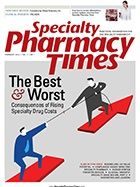Publication
Article
Complera by Gilead Sciences, Inc
Author(s):
Complera treats HIV infection in previously untreated adults with a viral load of 100,000 copies/mL or less.
COMPLERA (emtricitabine, rilpivirine hydrochloride, and tenofovir disoproxil fumarate) has been available in the United States since 2011 for treatment of HIV-1 infection in adult patients.
Complera is indicated for use in patients who have not previously used antiretrovirals and who have an HIV-1 RNA level ≤100,000 copies/mL upon treatment initiation, and to replace current therapy in adult patients who are currently using antiretroviral treatment and have very low virologic levels (ie, HIV-1 RNA levels <50 copies/mL).1
Complera has a black box warning for lactic acidosis and severe hepatomegaly with steatosis, as well as posttreatment acute exacerbations of hepatitis B infection. Its use is contraindicated in patients using medications that may reduce levels of rilpivirine to a clinically significant degree, such as carbamazepine, oxcarbazepine, phenobarbital, phenytoin, rifampin, rifapentine, dexlansoprazole, esomeprazole, lansoprazole, omeprazole, pantoprazole, rabeprazole, dexamethasone (when used as more than a single dose), and St. John’s wort.1
Mechanism of Action
Complera is composed of 2 nucleoside analog reverse transcriptase inhibitors (emtricitabine/tenofovir disoproxil fumarate) and the non-nucleoside reverse transcriptase inhibitor rilpivirine.1
Dosage and Administration
Each tablet of Complera contains 200 mg of emtricitabine, 25 mg of rilpivirine, and 300 mg of tenofovir disoproxil fumarate. Tablets should be taken once daily with food.1 Use of Complera is not approved in patients with a creatinine clearance <50 mL/min.
No dose adjustment is required in patients with mild to moderate hepatic impairment (ie, Child-Pugh class A or B), but treatment with Complera in severe hepatic impairment (ie, Child-Pugh class C) has not been studied.
Pharmacology and Pharmacokinetics
Emtricitabine has a half-life of 10 hours, rilpivirine has a half-life of 50 hours, and tenofovir disoproxil fumarate has a half-life of approximately 17 hours. Emtricitabine and tenofovir disoproxil fumarate are primarily excreted in the urine, while rilpivirine is primarily excreted in the feces. When Complera is taken with a meal, exposure to rilpivirine and tenofovir disoproxil fumarate are increased, while levels of emtricitabine remain unaffected.1
Clinical Studies
Treatment-naïve patients In a pooled group of treatment-naïve patients with HIV-1, patients received rilpivirine plus emtricitabine/tenofovir disoproxil fumarate (n = 550) or efavirenz plus emtricitabine/tenofovir disoproxil fumarate (n = 546) for 96 weeks.1,2
At week 96, the percentage of patients achieving an HIV-1 RNA level of <50 copies/mL was 77% in both groups. However, discontinuations due to adverse events or death were less common in patients receiving rilpivirine plus emtricitabine/tenofovir disoproxil fumarate (4% of patients) than in patients receiving efavirenz plus emtricitabine/tenofovir disoproxil fumarate (9% of patients).
The lower incidence of adverse events with Complera was primarily due to a lower incidence of neuropsychiatric side effects and rash.1,2
Treatment-experienced patients In treatment-experienced patients, researchers randomized patients in a 1:2 ratio to continue receiving a baseline regimen (n = 159) or to receive Complera (n = 317). Patients were required to have previously received a regimen of a ritonavir-boosted protease inhibitor with 2 nucleoside reverse transcriptase inhibitors have no history of virologic failure and have no history of resistance to rilpivirine, emtricitabine, or tenofovir disoproxil fumarate.1,3
At week 48, the percentage of patients achieving an HIV-1 RNA level of <50 copies/mL was 89% in patients receiving Complera and 90% in patients continuing baseline treatment. Discontinuations due to adverse events or death occurred in 2% of patients receiving Complera versus 0% of patients who stayed on the baseline regimen.1,3
Warnings and Precautions
Complera should not be used with other antiretroviral treatments that duplicate therapeutic ingredients (except rilpivirine in patients receiving rifabutin). In addition, Complera should not be used with lamivudine or lamivudine-containing products because emtricitabine is structurally similar to lamivudine.1,4
Drugs that increase gastric pH may reduce rilpivirine exposure. Patients should not take inorganic antacids less than 2 hours before or less than 4 hours after taking a dose of Complera, whereas H2-receptor antagonists should be taken no less than 12 hours before and no less than 4 hours after taking a dose of Complera.1
Use of Complera with CYP3A inducers or inhibitors may affect rilpivirine levels. For instance, due to the potential for increases in rilpivirine levels, clarithromycin, erythromycin, or telithromycin should be avoided. When a macrolide antibiotic is necessary, use of azithromycin should be considered.1
Patients receiving rifabutin should receive an additional 25 mg of rilpivirine (Edurant) with each dose to compensate for reductions in rilpivirine levels resulting from an interaction with rifabutin.1 Common adverse events with the combination may include depressive disorders, insomnia, headache, diarrhea, nausea, fatigue, abnormal dreams, and rash.
For a complete discussion of potential adverse events and drug interactions with Complera, please consult the product package insert.1 SPT
References
- COMPLERA (emtricitabine, rilpivirine hydrochloride, and tenofovir disoproxil fumarate) [package insert]. Foster City, CA: Gilead Sciences, Inc; May 2015.
- Behrens G, Rijnders B, Nelson M, et al. Rilpivirine versus efavirenz with emtricitabine/tenofovir disoproxil fumarate in treatment-naïve HIV-1-infected patients with HIV-1 RNA ≤100,000 copies/mL: week 96 pooled ECHO/THRIVE subanalysis. AIDS Patient Care STDS. 2014;28(4):168-175.
- Brunetta J, Moreno Guillén S, Antinori A, et al. Patient-Reported Outcomes After a Switch to a Single-Tablet Regimen of Rilpivirine, Emtricitabine, and Tenofovir DF in HIV-1-Positive, Virologically Suppressed Individuals: Additional Findings From a Randomized, Open-Label, 48-Week Trial. Patient. 2015;8(3):257-267.
- Ford N, Shubber Z, Hill A, et al. Comparative efficacy of Lamivudine and emtricitabine: a systematic review and meta-analysis of randomized trials. PLoS One. 2013;8(11):e79981.







